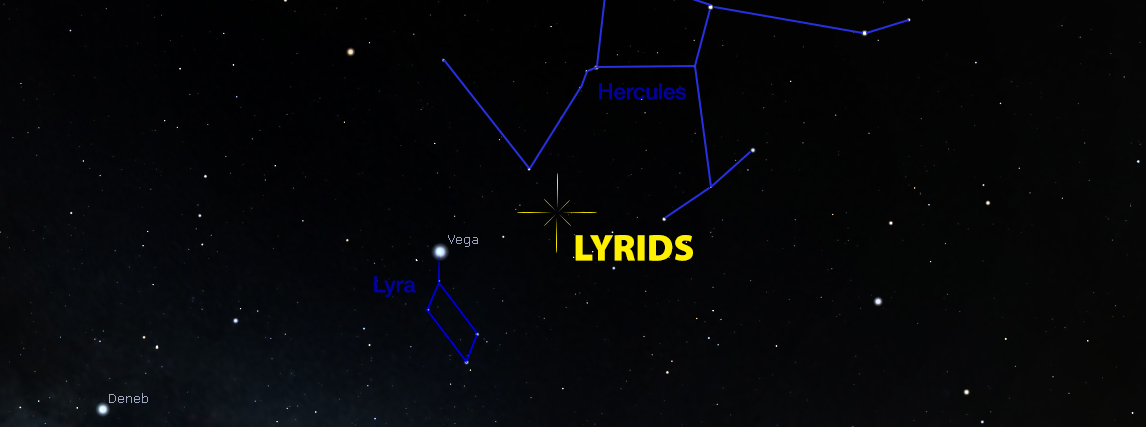After three months of low rates, April ushers in two major showers (Lyrids and eta Aquariids) and a temporary upswing in meteor activity. The first of these showers is the Lyrids, which are active from April 18 through the 25th. Activity for this shower is low away from the peak night which expected to occur on Friday evening /Saturday morning April 21/22. Peak rates are predicted to occur near 17:00 Universal Time on April 22, which corresponds to 1300 (1pm) EDT and 1000 PDT for observers in North America. Since these times are after sunrise your best rates will be seen during the last hour before dawn on the 22nd.
On the night of maximum activity the Lyrid radiant is actually located in eastern Hercules, seven degrees southwest of the brilliant star Vega (Alpha Lyrae). This area of the sky lies near or below the horizon during the early evening hours, depending on your latitude. It attains a decent elevation between midnight and 0100 and is best situated high in a dark sky just before the start of morning twilight. These are the best times in which to try and view Lyrid activity. Normal Lyrid activity produces around 15 shower members per hour at maximum. While the Lyrids are not the strongest shower, it is notable that shower members will occasionally reach fireball intensity.
On the night of maximum activity the moon will be at its waning crescent phase and will be located in the constellation of Aquarius. Although the crescent phase is thin, it will still be bright enough to be a nuisance. It would be best to face toward the northern half of the sky with the moon at your back. This will allow you to see the fainter Lyrids, which will be more numerous than the bright ones. Observers in the Southern Hemisphere will see very little Lyrid activity as the radiant will be located low in the northern sky. All Lyrid meteors will trace back to the radiant area in eastern Hercules. There will be other showers and random activity visible during this period so not all meteors will be members of the Lyrid shower. Lyrid meteors will appear to travel swiftly through the sky unless they are seen near the radiant or near the horizon. Lyrids seen there will move more slowly as they are moving towards you (if seen near the radiant) or away from you (if seen near the horizon).

The Lyrids are particles from Comet Thatcher (C/1861 G1). This comet has an orbital period of 415 years and the last time it was a perihelion was back in 1861. This shower has produced several notable outbursts. These occurred in the years 1803, 1849, 1850, 1884, 1922, 1945, and 1982. The 1803 event seems to the strongest as rates exceeded 500 Lyrids per hour at maximum. The 1982 event was seen from eastern USA where rates were estimated near 100 per hour at maximum. I witnessed the final portions of this outburst as I drove out to dark sky site. Lyrid meteors were seen shooting upward from the northeastern horizon. Once I arrived at my site the outburst was over and very little activity was seen the remainder of the night. The next possible outburst for this shower is predicted to occur in 2040 and 2041.
Let us know what you see in 2017!
 American Meteor Society
American Meteor Society
I was driving into Graham, Texas from Hwy 67 @ 1:18 pm and I saw something falling out of the sky. It looked like it was red hot maybe burning leaving a trail and then in a flash was gone. It was out NE towards Loving, Texas. I was Not sure if it was a meteor, but it could have been. It was strange seeing that in the middle of the day and how bright it was.
I’m curious how you got your predicted peak at 1700 UT? The IMO predicts a peak at 1200 UT as do a few other sites. Any insight would be greatly appreciated.
Wade and All,
The IMO timing is obtained from visual observations submitted to the IMO from 1988-2000. My timing is obtained from IMO video data from 1988-2013, consisting of roughly 4000 Lyrid meteors. I have a little more faith in video cameras as they are not susceptible to tiredness and incorrect shower association. My experience has shown the video predictions to be reliable, or I would not use them. It will be difficult to verify the peak this year since the video peak will occur over the eastern Pacific Ocean. Let’s see what happens over North America.
Robert Lunsford
I assume rates could still be decent Saturday night/Sunday AM, or at least the chance for a few fireballs, correct? We had no chance with the weather Friday night sadly. What rates are possible tonight/tomorrow AM?
Chris and All,
If you watch away from city lights you may still be able to count around 5 Lyrid meteors per hour on Sunday morning. There will also be some random activity not associated with the Lyrids so 10 meteors per hour total is also possible.
I hope your weather cooperates!
Robert Lunsford
Hi Robert. As mentioned, it seems like the general astronomy information sites (Starwalk, spaceweather.com, etc) broadcast the peak of the Lyrids later than you did so that people missed the peak by a day. – Thomas
Thomas and All,
This is unfortunate as a lot of folks missed the best part of the display. The Lyrids do peak on the morning of the 23rd in the 2 years before leap year such as 2014 and 2015. But with the extra day in leap year it shifted back to the 22nd in 2016 and 2017.
Robert Lunsford